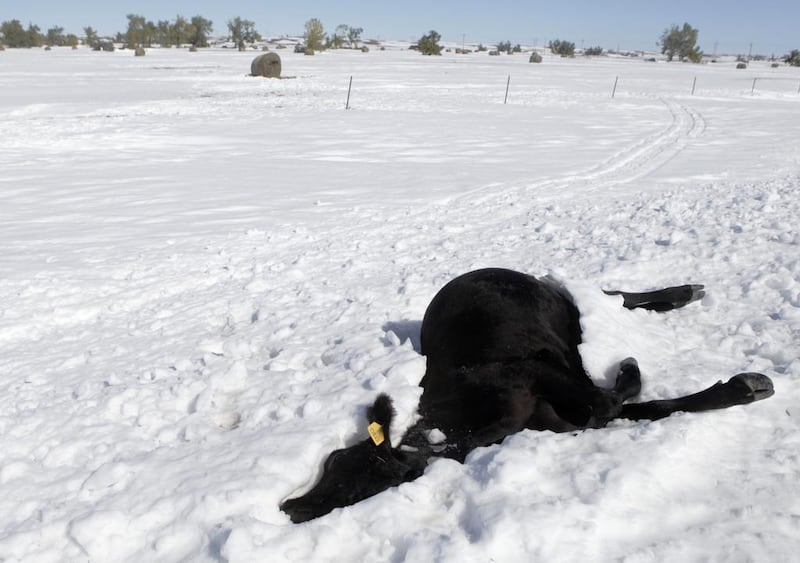SIOUX FALLS, SOUTH DAKOTA // Western South Dakota farmers are reeling from the loss of tens of thousands of cattle in last weekend’s blizzard, and many will dispose of carcasses in pits.
Farmer Heath Ferguson said the storm killed 96 per cent of his herd of 100 black Angus and Limousin cattle, a hit worth about US$250,000 (Dh918,300). He said total losses topped more than 1,000 head, as six other herds were roaming the family’s 6,500 hectares east of Sturgis.
Up to 1.2 metres of snow fell in the Black Hills area last weekend. Reports of 50 or more centimetres of snow were common and at least two deaths were attributed to the storm, which took a particularly heavy toll on livestock.
Mr Ferguson said most farmers were not insured for storm-related damage.
“It’s cost-prohibitive for a producer,” he said on Sunday. “Unless you’re a really big operator, you can’t afford to pay for the insurance.”
Cattle farmers dealing with weather-related losses would typically turn to the federal Livestock Indemnity Programme, but that farm bill provision has expired and its future is in flux due to congressional gridlock and the continuing federal shutdown.
“We’re an independent, pretty self-sufficient bunch, but we need help,” Mr Ferguson said.
South Dakota govenor Dennis Daugaard and US senator John Thune did an aerial assessment of the blizzard damage and livestock losses. State officials said at least 10,000 to 20,000 head of livestock died, but the estimate would likely rise.
The South Dakota Stockgrowers Association estimates that western South Dakota lost at least 5 per cent of its cattle, most of which were raised for slaughter. Nearly a third of the state’s 3.7 million cattle and calves are in the western part of the state.
Farmers who lost cattle will be able to dispose of the carcasses for free at several pits being dug in Pennington County, according to the county’s Emergency Operations Centre. The county is coordinating the effort because the US Farm Service Agency is closed during the shutdown.
Livestock owners were encouraged to document all animal losses with pictures, vaccination and hauling receipts in case disaster payments became available in the future.
South Dakota Farmers Union president Doug Sombke said that even if the federal government was open and Congress could reach a compromise on a new farm bill, it would take months to implement the Livestock Indemnity Programme.
Meanwhile, the Stockgrowers Association, the South Dakota Cattlemen’s Association and the South Dakota Sheep Growers Association are seeking donations to a relief fund that has been set up to help ranchers, and a couple of Montana groups are asking local farmers to donate cattle and sheep.
Mr Ferguson, who also makes his living by working in the Wyoming coal fields, said he owns his herd, but many struggling ranchers have had to borrow money to stay in business.
“There’s an awful lot of producers out here that sold our herds down because of the drought,” he said. “A lot of people are into the financial institutions pretty hard.”
* Associated Press





